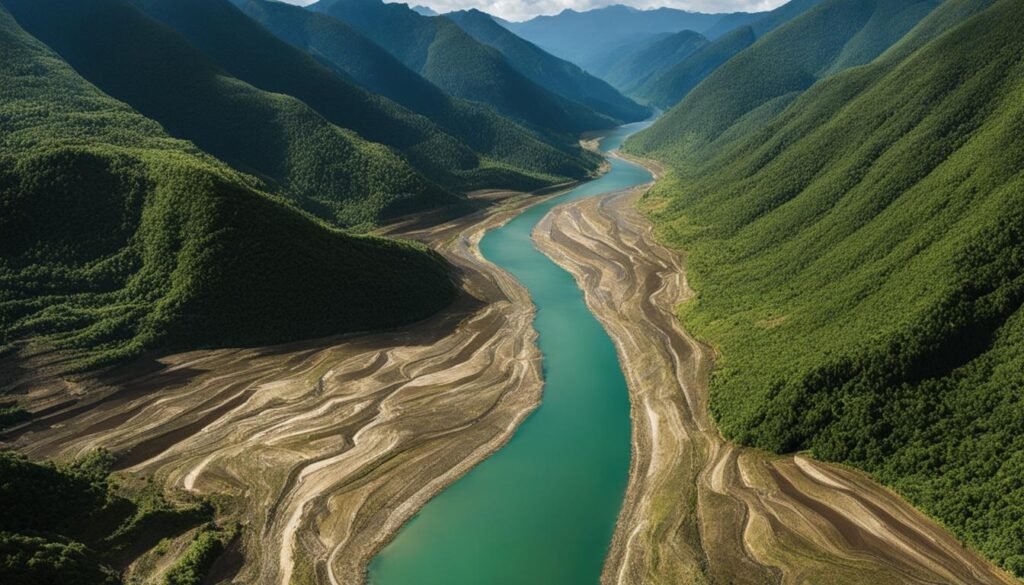As an environmental journalist, I am constantly intrigued by the complex interplay between geography and environmental studies. The field of geography offers a unique perspective into the relationships between geographic places, natural systems, society, and cultural activities. When it comes to understanding and addressing environmental challenges, geography plays a vital role in providing insights and solutions.
In essence, geography can be divided into two main branches: human geography and physical geography. Human geography focuses on the spatial aspects of human activities, such as urbanization and land-use patterns, while physical geography explores the physical elements and spatial processes of the Earth’s environmental systems. Together, these branches provide a comprehensive understanding of the complex interactions between humans and the environment.
Environmental geographers are at the forefront of studying and planning communities, examining global warming, deforestation, pollution, and other critical environmental issues. They employ cutting-edge spatial technologies like Geographic Information Systems (GIS) and Global Positioning Systems (GPS) to analyze and understand the Earth and its inhabitants.
Throughout this article, we will delve deeper into the role of geography in environmental studies, the significance of pursuing a degree in geography and environmental studies, the environmental challenges and solutions explored in geography studies, the intersection of geography with sustainability and environmental education, and the vast array of research and career opportunities in environmental geography.
Key Takeaways:
- Geography is a science that examines the relationships between geographic places, natural systems, society, and cultural activities.
- It encompasses human geography, which focuses on the spatial aspects of human activities, and physical geography, which studies the Earth’s environmental systems.
- Environmental geographers play a crucial role in studying and addressing environmental challenges, utilizing spatial technologies like GIS and GPS.
- Pursuing a degree in geography and environmental studies offers various career opportunities in environmental management, planning, research, and education.
- The integration of geography into environmental education promotes sustainability and empowers individuals to make informed choices.
The Role of Geography in Environmental Studies
Geography plays a crucial role in environmental studies as it examines the linkages between human activity and natural systems. Geographers were among the first scientists to recognize the impact of human-induced changes on the environment. Environmental geography focuses on studying the spatial aspects of human-environment interactions, including the distribution of resources, land use patterns, and the effects of human activities on ecosystems.
Environmental geography is an interdisciplinary field that combines elements of physical geography, human geography, and environmental science. By analyzing spatial relationships, environmental geographers gain a deeper understanding of how human actions affect the environment and the resulting consequences.
One of the key purposes of environmental geography is to identify and analyze the complex interactions between human societies and their natural surroundings. This involves studying the distribution of resources and the impacts of human activities on the Earth’s ecosystems. By understanding these interactions, environmental geographers can contribute to the development of sustainable solutions that address pressing environmental challenges.
Key Aspects of Environmental Geography
1. Distribution of Resources: Environmental geography examines how resources are distributed across the Earth’s surface and the implications for human societies. This includes studying the availability of natural resources such as water, minerals, and energy sources.
2. Land Use Patterns: By analyzing land use patterns, environmental geographers investigate how human activities shape the Earth’s surface. This includes studying urbanization, agriculture, deforestation, and other forms of land transformation.
3. Human-Environment Interactions: Environmental geography explores the complex interactions between human societies and the natural environment. It examines how human activities, such as industrialization, transportation, and resource exploitation, impact ecosystems and natural processes.
4. Sustainable Development: Environmental geographers contribute to the development of sustainable practices by studying the environmental, social, and economic aspects of human-environment interactions. They help identify strategies for balancing resource use, environmental preservation, and societal well-being.
The field of environmental geography offers diverse career opportunities. Professionals in this field can pursue environmental geography jobs in research institutions, environmental consulting firms, government agencies, NGOs, and international organizations. They play a critical role in analyzing and managing environmental issues, implementing sustainability initiatives, and contributing to the development of effective environmental policies.
Pursuing a Degree in Geography and Environmental Studies
Are you passionate about the environment and want to make a positive impact on the world? Pursuing a degree in geography and environmental studies can provide you with the knowledge and skills to address pressing environmental challenges. Many universities offer comprehensive programs that cover a wide range of topics, including geography and environmental science, geography and environmental management, and geography and environmental planning.
Through these degree programs, students dive deep into the study of the environment, learning about the impact of human activities on ecosystems and how natural systems function. They also develop an understanding of strategies for sustainable development, which are crucial for creating a greener future.
Graduates of geography and environmental studies programs have a variety of career paths to choose from. They can pursue roles in environmental management, where they work to protect and conserve natural resources. Others may explore urban and regional planning, helping communities develop in environmentally-friendly ways. Some graduates may even join conservation organizations, actively advocating for the preservation of our planet.
Continuing education at the graduate level is also a viable option for those interested in furthering their knowledge and expertise in the field. Graduate programs in geography and environmental studies allow individuals to specialize in specific areas of interest and conduct advanced research to contribute to the field.
By pursuing a degree in geography and environmental studies, you can gain the necessary skills and knowledge to become an environmental leader and make a difference in the world. Start your journey towards a rewarding career by enrolling in a reputable program today!
Key Takeaways:
- Geography and environmental studies degree programs provide a comprehensive understanding of the subject.
- Topics covered include geography and environmental science, geography and environmental management, and geography and environmental planning.
- Students learn about the impact of human activities on the environment, how natural systems function, and strategies for sustainable development.
- Graduates can pursue careers in environmental management, urban and regional planning, conservation organizations, or continue their education at the graduate level.


Environmental Challenges and Solutions Explored in Geography Studies
Geography studies offer a unique perspective on a wide range of environmental challenges facing our world today. With a focus on human geography environmental issues, this field examines the spatial aspects of human activities that have a significant impact on the environment. From urbanization and deforestation to resource exploitation, geographers delve into the causes and consequences of these issues to identify potential solutions.
Environmental geography topics cover a diverse range of subjects, including climate change, natural resource management, and sustainable development. By studying these topics, geographers gain a deeper understanding of the complex interactions between human societies and the environment, paving the way for innovative strategies to address these pressing issues.
Environmental studies programs play a crucial role in preparing students to tackle environmental challenges effectively. These interdisciplinary programs provide students with the knowledge and skills to analyze and address environmental issues from various angles. Through a combination of coursework and hands-on experiences, students develop a comprehensive understanding of environmental systems and learn how to develop sustainable solutions.
Many universities offer specialized programs in environmental geography that allow students to explore these topics in depth. These programs provide opportunities for students to engage in fieldwork, research, and internships, further enhancing their understanding of environmental issues and their potential solutions.
By immersing themselves in the study of environmental challenges and solutions, geography students become equipped with the knowledge and skills to make a positive impact on our planet. Whether it’s through research, policy development, or community engagement, the insights gained from geography studies contribute to the ongoing efforts to create a more sustainable and environmentally conscious world.
Geography, Sustainability, and Environmental Education
Geography plays a significant role in promoting sustainability and environmental education. The spatial perspective provided by geography helps in understanding the interconnectedness of environmental, social, and economic systems.
The Importance of Sustainable Geography
Sustainable geography explores ways to balance human needs with environmental preservation. It involves studying the impact of human activities on the environment and finding solutions that promote long-term sustainability. By considering the relationships between people, places, and resources, sustainable geography aims to create a harmonious coexistence between society and the environment.
Integrating Environmental Education
Environmental education, which incorporates geographical concepts, plays a crucial role in raising awareness about environmental issues and equipping individuals with the knowledge and skills to make sustainable choices. By integrating geography into environmental education programs, individuals can gain a deeper understanding of the causes of environmental challenges and explore potential solutions.


Encouraging Active Engagement
Environmental education programs often encourage active engagement with environmental challenges. By incorporating hands-on activities, fieldwork, and case studies, individuals can develop a practical understanding of geographical concepts and apply them to real-world situations. This active engagement fosters a sense of responsibility and empowers individuals to take positive actions towards a more sustainable future.
A Path Towards Sustainability
By leveraging the spatial perspective of geography and promoting environmental education, we can work towards building a more sustainable world. Geography provides the tools, knowledge, and understanding needed to navigate the complex interactions between humans and the environment. Through sustainable geography and environmental education, we can create a future where ecological balance, social equity, and economic prosperity coexist harmoniously.
Research and Careers in Environmental Geography
Environmental geography offers a wealth of opportunities for research and diverse career paths. As researchers in this field, we have the privilege of investigating pressing environmental issues, conducting spatial analysis, and contributing to the development of sustainable solutions. The beauty of environmental geography lies in the multitude of sectors we can explore, from academic institutions to research organizations and government agencies.
One of the exciting aspects of pursuing a career in environmental geography is the wide range of job prospects available. Environmental consulting is a popular path, with professionals applying their expertise to advise businesses, governments, and organizations on environmental matters. Others may choose to specialize in natural resource management, where they play a crucial role in conserving and sustainably utilizing our planet’s resources.
Urban planning is another field where environmental geographers can make a significant impact. By analyzing the environmental implications of urban development, we can help create cities that are sustainable, resilient, and harmonious with nature. Sustainability itself is a flourishing area, encompassing roles that focus on developing strategies and policies to mitigate environmental challenges.
Career Opportunities in Environmental Geography:
- Environmental consulting
- Natural resource management
- Urban planning
- Sustainability
- Environmental research
- Policy development
Professionals in these roles apply their geographic knowledge to address environmental challenges, develop land-use plans, and create sustainable policies. Through our work, we strive to protect natural ecosystems, promote ecological balance, and ensure a better future for generations to come.
Conclusion
Geography and environmental studies are essential for understanding and addressing the environmental challenges we face. By examining the complex relationships between humans, natural systems, and society, geographers contribute to the development of sustainable solutions. Through the pursuit of a degree in geography and environmental studies, individuals can unlock a wide range of career opportunities in fields such as environmental management, planning, research, and education.
Integrating geography into environmental education is a crucial step towards creating a more sustainable future. By promoting the understanding of the geography of the environment, we can empower individuals to make informed decisions and take proactive measures to protect our planet. The application of geographic principles in environmental education encourages active engagement and fosters environmental literacy.
As we explore the geography of the environment, it becomes evident that sustainable practices are key to preserving our planet. Incorporating sustainable concepts into our daily lives, from personal choices to city planning, can significantly reduce our environmental impact. By embracing spatial thinking and leveraging the knowledge gained through geography and environmental studies, we can work towards a healthier and more sustainable planet for future generations.
FAQ
What is geography environmental science?
Geography environmental science is a field that explores the relationships between geographic places, natural systems, society, and cultural activities. It examines the impact of human activities on the environment and utilizes spatial technologies to study the Earth and its inhabitants.
What are some environmental geography careers?
Environmental geography careers include roles in environmental management, urban and regional planning, conservation organizations, and research institutions. Professionals in these fields analyze and manage environmental issues, develop land-use plans, and create policies for sustainable development.
What topics does environmental geography cover?
Environmental geography topics cover areas such as climate change, natural resource management, and sustainable development. It focuses on examining the spatial aspects of human-environment interactions, including the distribution of resources, land use patterns, and the effects of human activities on ecosystems.
How does geography contribute to environmental studies?
Geography plays a crucial role in environmental studies by examining the linkages between human activity and natural systems. Geographers were among the first scientists to recognize the impact of human-induced changes on the environment. They study the spatial aspects of human-environment interactions and contribute to the development of sustainable solutions.
What are some career opportunities in geography and environmental studies?
Pursuing a degree in geography and environmental studies can lead to various career opportunities in fields such as environmental management, planning, research, and education. Graduates can work in government agencies, research organizations, conservation organizations, or pursue further education at the graduate level.
How does geography contribute to sustainability and environmental education?
Geography plays a significant role in promoting sustainability by exploring ways to balance human needs with environmental preservation. It provides a spatial perspective that helps in understanding the interconnectedness of environmental, social, and economic systems. Environmental education integrates geography to educate individuals about environmental issues, causes, and potential solutions, fostering environmental literacy and empowering individuals to make sustainable choices.
What is the role of researchers in environmental geography?
Researchers in environmental geography investigate environmental issues, conduct spatial analysis, and contribute to the development of sustainable solutions. They work in academic institutions, research organizations, or government agencies. By applying their geographic knowledge, they address environmental challenges, develop land-use plans, and create policies for sustainable practices.
What is the geography of the environment?
The geography of the environment refers to the study of the relationships between geographic places, natural systems, society, and cultural activities. It encompasses the examination of the impact of human activities on the environment and the spatial processes of the Earth’s environmental systems.









